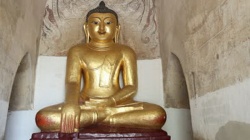Difference between revisions of "Ārya Ratnamegha Sutra"
Jump to navigation
Jump to search
(Created page with "thumb|250px| All forms of meditation can be divided into two types: Samatha and Vipasyana. The Ratnamega sutra (Cloud of Jewels ...") |
|||
| Line 1: | Line 1: | ||
[[File:Stocuyhugan.jpg|thumb|250px|]] | [[File:Stocuyhugan.jpg|thumb|250px|]] | ||
All [[forms]] of [[meditation]] can be divided into two types: [[Samatha]] and [[Vipasyana]]. The [[Ratnamega sutra]] ([[Cloud of Jewels sutra]]) ([[Discourse Like a Cloud of Jewels]]) defines these quite simply. "[[Samatha]] is [[concentration]]. [[Vipasyana]] is analysis of details of [[experience]]." | All [[forms]] of [[meditation]] can be divided into two types: [[Samatha]] and [[Vipasyana]]. The [[Ratnamega sutra]] ([[Cloud of Jewels sutra]]) ([[Discourse Like a Cloud of Jewels]]) defines these quite simply. "[[Samatha]] is [[concentration]]. [[Vipasyana]] is analysis of details of [[experience]]." | ||
| + | |||
| + | '''[[Ratnamegha Sutra]]''', or the ''[[Cloud of Jewels Sutra]]'' (Skt. ''[[Ratnamegha-sūtra]]'', Tib. {{BigTibetan|[[དཀོན་མཆོག་སྤྲིན་གྱི་མདོ།]]}}, [[Wyl.]] ''[[dkon mchog sprin gyi mdo]]'') is considered to be the first [[sutra]] translated into [[Tibetan]] by [[Thonmi Sambhota]]. <ref>[[Patrul Rinpoche]], ''[[The Words of My Perfect Teacher]]'', Translated by [[Padmakara Translation Group]], Published by Harper Collins, ISBN 0-06-066449-5, Page 342 and also Bibliography page 441.</ref> | ||
| + | |||
| + | ==References== | ||
| + | <small><references/></small> | ||
| + | |||
| + | ==[[Tibetan]] Text== | ||
| + | *[[Derge Kangyur]], vol.64, ff.1r-112v (pp.1-224) | ||
| + | |||
| + | ==External Links== | ||
| + | *[http://tbrc.org/#library_work_ViewByOutline-O1GS1298001JW13738|W22084 Read the Tibetan text online at Tibetan Buddhist Resource Centre] | ||
{{RangjungWiki}} | {{RangjungWiki}} | ||
[[Category:Ārya Ratnamegha Sutra]] | [[Category:Ārya Ratnamegha Sutra]] | ||
Latest revision as of 06:57, 19 March 2014
All forms of meditation can be divided into two types: Samatha and Vipasyana. The Ratnamega sutra (Cloud of Jewels sutra) (Discourse Like a Cloud of Jewels) defines these quite simply. "Samatha is concentration. Vipasyana is analysis of details of experience."
Ratnamegha Sutra, or the Cloud of Jewels Sutra (Skt. Ratnamegha-sūtra, Tib. དཀོན་མཆོག་སྤྲིན་གྱི་མདོ།, Wyl. dkon mchog sprin gyi mdo) is considered to be the first sutra translated into Tibetan by Thonmi Sambhota. [1]
References
- ↑ Patrul Rinpoche, The Words of My Perfect Teacher, Translated by Padmakara Translation Group, Published by Harper Collins, ISBN 0-06-066449-5, Page 342 and also Bibliography page 441.
Tibetan Text
- Derge Kangyur, vol.64, ff.1r-112v (pp.1-224)
